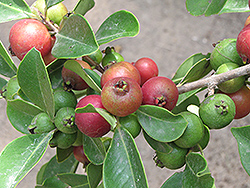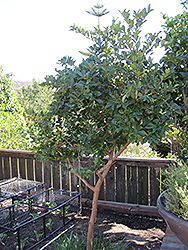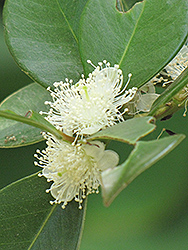It's all about ...
plants

Height: 20 feet
Spread: 15 feet
Sunlight:
![]()
![]()
Hardiness Zone: 9b
Other Names: Strawberry Guava, Cherry Guava
Description:
A large evergreen shrub or small tree with an upright habit and attractive leaves arranged in pairs; creamy white flowers are followed by orange to dark red fruit that is juicy and sweet; considered very invasive in some warm climate areas
Edible Qualities
Cattley Guava is a small tree that is typically grown for its edible qualities, although it does have ornamental merits as well. It produces dark red round fruit which are typically harvested when mature. The fruits have a sweet taste and a soft texture.
The fruit are most often used in the following ways:
- Fresh Eating
- Cooking
- Preserves
- Juice-Making
- Canning
Features & Attributes
Cattley Guava is clothed in stunning white pincushion flowers with creamy white anthers along the branches from late winter to late fall. It has green foliage with grayish green undersides. The glossy oval pinnately compound leaves remain green throughout the winter. It features an abundance of magnificent dark red berries from early summer to mid fall. The fruit can be messy if allowed to drop on the lawn or walkways, and may require occasional clean-up. The peeling gray bark and coppery-bronze branches are extremely showy and add significant winter interest.
This is a multi-stemmed evergreen tree with an upright spreading habit of growth. Its average texture blends into the landscape, but can be balanced by one or two finer or coarser trees or shrubs for an effective composition. This is a high maintenance plant that will require regular care and upkeep, and is best pruned in late winter once the threat of extreme cold has passed. It is a good choice for attracting birds, bees and butterflies to your yard. Gardeners should be aware of the following characteristic(s) that may warrant special consideration;
- Suckering
- Invasive
- Self-Seeding
Aside from its primary use as an edible, Cattley Guava is sutiable for the following landscape applications;
- Accent
- Mass Planting
- Hedges/Screening
- Container Planting
Planting & Growing
Cattley Guava will grow to be about 20 feet tall at maturity, with a spread of 15 feet. It has a low canopy with a typical clearance of 2 feet from the ground, and is suitable for planting under power lines. It grows at a medium rate, and under ideal conditions can be expected to live for 40 years or more. This is a self-pollinating variety, so it doesn't require a second plant nearby to set fruit.
This tree is quite ornamental as well as edible, and is as much at home in a landscape or flower garden as it is in a designated edibles garden. It does best in full sun to partial shade. You may want to keep it away from hot, dry locations that receive direct afternoon sun or which get reflected sunlight, such as against the south side of a white wall. It prefers to grow in average to moist conditions, and shouldn't be allowed to dry out. This plant should not require much in the way of fertilizing once established, although it may appreciate a shot of general-purpose fertilizer from time to time early in the growing season. It is particular about its soil conditions, with a strong preference for rich, acidic soils. It is somewhat tolerant of urban pollution. Consider applying a thick mulch around the root zone over the growing season to conserve soil moisture. This species is not originally from North America..
Cattley Guava is a good choice for the edible garden, but it is also well-suited for use in outdoor pots and containers. Its large size and upright habit of growth lend it for use as a solitary accent, or in a composition surrounded by smaller plants around the base and those that spill over the edges. It is even sizeable enough that it can be grown alone in a suitable container. Note that when grown in a container, it may not perform exactly as indicated on the tag - this is to be expected. Also note that when growing plants in outdoor containers and baskets, they may require more frequent waterings than they would in the yard or garden. Be aware that in our climate, most plants cannot be expected to survive the winter if left in containers outdoors, and this plant is no exception. Contact our experts for more information on how to protect it over the winter months.
This plant is not reliably hardy in our region, and certain restrictions may apply; contact the store for more information.


